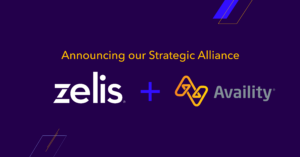
Kaitlin Howard is a researcher and writer producing insightful content across the healthcare revenue cycle. She has written and produced content for Zelis, Waystar, and Recondo Technology, as well as agencies. With a B.A. in English and Writing from University of Denver, Kaitlin stays current on market updates on claims management and healthcare payments, publishing a regular educational blog series on industry trends and Zelis offerings.
Zelis Executive Vice President of Solutions Eileen Dougherty joins Brian Zimmerman with Becker’s Hospital Review to discuss why the healthcare payment system is fragmented and what other challenges healthcare’s misaligned incentives create for payers, providers, and members.
We’ll discuss the highlights below, but you also can listen to the full podcast here:
The why
Let’s take a look at the numbers.
The United States currently has more than 900 operating payers. And these companies offer 67.3% of private care and 34.4% of public care through their health plans.
And while we don’t have the exact data for the number of provider tax ID numbers (TIN), we can ball park it at around 1M.
Now consider the amount of patients interacting with the healthcare process at any given time. Here’s a hint: just under 84% of adults visited a healthcare professional in 2020.
With a healthcare payment system of that size, it’s not surprising when it comes across as fragmented. Especially since each organization operating within that system have their own incentives.
Need an example?
When a problem occurs inside a provider space, the provider will do everything to solve the problem. Obviously. But they typically only focus on the provider perspective. How their actions impact the health plan’s, employer’s, and member’s operations are, often, an afterthought.
And, as you can imagine, those actions ripple.
Enter: our current disjointed healthcare payments system.
The challenge
Here’s a day-in-the-life situation.
You’re a practice manager that works inside a healthcare practice.
You come into the office, coffee in hand (of course), and take a deep breath (just one of many for the day).
It’s your job to make sure all the patients coming into your office today are currently active in the health plans they’ve supplied for you. And, boy, do you have your work cut out for you.
Those patients coming in could have as many as 10-15 different health plans. That’s 10-15 different validation systems.
Now imagine something goes wrong with just a third of those validations. You are expected to be able to navigate the, at minimum, five different processes for handling those anomalies.
But that’s not all.
You also have to notify each individual patient.
So you ring them up and give them the spiel, “Hi, I’m Jane Doe calling from Healthcare Practice ABC about your scheduled visit today. There seems to be a problem with your insurance coverage. We have a couple options for you. You can fully handle the bill yourself, you can pay upfront and then submit the claim and bill to your insurance company after your care is complete, or we can keep trying to mitigate the situation and update you when we know more.”
After patients start coming in to receive care, you must then submit each claim. Which means you also need to manage denials. Which means sometimes you’re billing a patient who came in months ago or billing a patient multiple times. (Cue groans here.)
With all the different layers and additional systems and processes, you can see how easily this day-in-the-life takes on a whole new level of stress.
The risks
Healthcare payments is a $4.1T industry. (Yes, trillion with a T.)
That’s an unfathomable amount of money moving through an outdated, disjointed system with lots of areas for, you guessed it, cybersecurity vulnerabilities.
Hello, breakage, fault, and fraud.
At every step of the process, it’s vital that account numbers, member, payer, and provider data, and the money itself is secured.
But when you consider that those processes need to be secured from, not only, Payer A to Provider A, but also, Payer B to Provider A, and so on and so forth for as long as we both shall live, you can see the potential for some serious security issues.
The wrap up
Healthcare is complex. We get it. But your payment system doesn’t have to be.
Time is money, and it’s no secret that there is never enough of either. The key to putting a little back in your wallet is efficiency. And let’s face it. Communicating via decades-old technology isn’t going to get the job done.
It’s time to make the shift to a specialized payment network vendor.
If you’re interested in finding out how Zelis can support your organization’s current and future payment workflows, contact us here.



